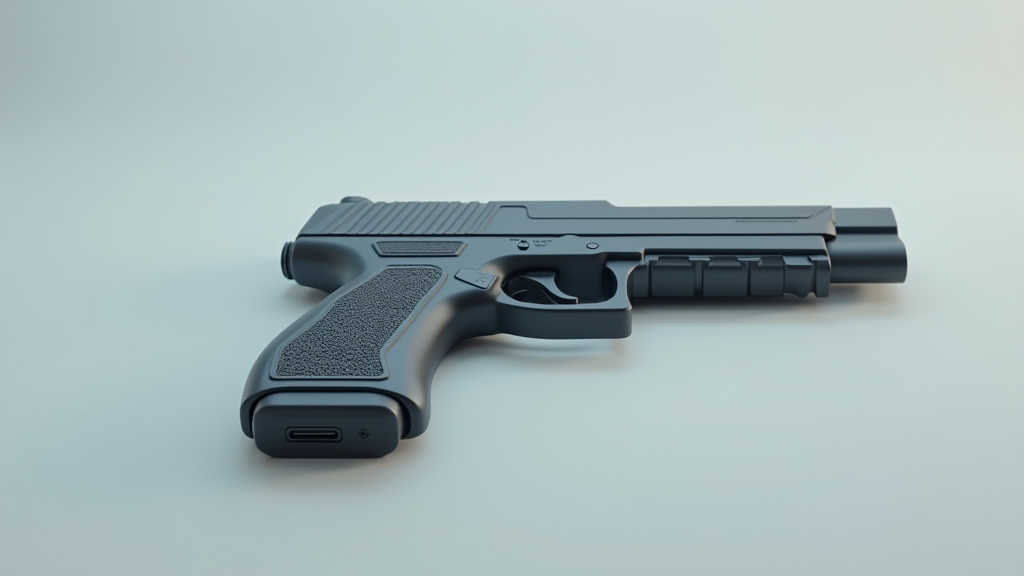Carrying a Byrna for personal defense has become more popular in recent years. Many people are drawn to its non-lethal nature and ease of use.
This article explains the legalities of carrying a Byrna in your state and provides guidance to help you stay informed. It is important to understand your state laws and the limitations that come with using self-defense tools like the Byrna.
What Is a Byrna and How Does It Work?
The Byrna is a self-defense device that uses chemical projectiles to temporarily disable attackers. It was designed as a non-lethal option for personal safety.
Many people appreciate the Byrna because it offers a quick method of defense without inflicting permanent damage. In many regions, self-defense tools that do not involve lethal force are becoming more widely accepted by legal entities.
The device is small and easy to carry. It can be stored conveniently in a bag or on a belt. The Byrna works by releasing a chemical irritant that causes intense discomfort.
This reaction can deter potential attackers, making it easier for the user to escape dangerous situations. Its compact design and reliability have contributed to its increasing appeal among those who want an extra layer of security.
Engineered with safety and reliability in mind, the Byrna undergoes rigorous testing to ensure it functions properly during emergencies. Its design incorporates user-friendly features that allow for a rapid response under stressful conditions.
Moreover, the Byrna is built with a focus on minimizing unintended injuries, making it an attractive choice for individuals seeking to protect themselves while reducing the potential for permanent harm.
An Overview of Self-Defense Laws in the United States
Self-defense tools have a rich legal history in the United States. Laws on carrying non-lethal weapons like the Byrna differ greatly between states. Some states have very clear regulations. In these states, devices like the Byrna are legal as long as they are carried with proper intent. Other states have vague rules.
These ambiguous guidelines can lead to misunderstandings about what is permitted and what falls outside the legal boundaries.
Many people equate the Byrna to pepper spray due to its intended temporary incapacitation feature. However, because the Byrna fires a physical projectile, it is subject to more specific legal criteria.
Regulations often focus on the composition of the projectile, its potential for injury, and the scenarios in which it can be deployed. Such distinctions underline the importance of researching state-specific laws before carrying any self-defense device.
Furthermore, legal interpretations of self-defense vary across jurisdictions. In some areas, the laws have been codified over decades following high-profile incidents, while in others, new technologies have forced lawmakers to revisit outdated rules. This evolving legal backdrop means that staying informed is essential for anyone considering carrying a Byrna.
Key Legal Considerations When Carrying a Byrna
Before carrying a Byrna, it is crucial to grasp the legal implications involved. Knowing your rights and responsibilities can help you avoid unwanted legal entanglements. Here are some important factors to consider:
- Device Specifications: Some states have clear guidelines regarding the specifications of self-defense devices. Ensure that your Byrna meets these requirements by checking the device manual and comparing it with state guidelines. This practice reduces legal risks and promotes safe usage.
- Usage Intent: The right to self-defense is tightly linked to the idea of using force reasonably. The Byrna should only be deployed when there is a genuine threat. Using it in situations that do not warrant such measures can result in legal trouble. It is important to evaluate each situation carefully before taking action.
- State-Specific Laws: Since laws differ from one state to another, studying local regulations is essential. If you travel frequently, keep in mind that what is permitted in one state might be regulated differently in another. Maintaining a copy of your state’s guidelines or checking reliable legal websites can be very useful.
- Prior Disciplinary Record: Some legal trends suggest that individuals with certain criminal records may face limitations when carrying self-defense devices. Consulting with legal experts can clarify whether your personal history might impact your legal standing regarding self-defense tools.
Additionally, consider the potential liability issues you might face if the device is misused or if a misunderstanding arises. Responsible ownership includes being aware of the possible consequences and taking proactive steps to mitigate legal risks.
Personal Experience
When it came time for me to take my personal protection seriously, I decided to purchase a handgun. Since I had friends in the law enforcement industry, I sought their assistance.
They recommended a good handgun to purchase and offered training to use it. I also had to get a permit to carry the weapon. The entire process, from purchase to feeling comfortable using the handgun, took five months.
With practice, I was lethal at fifteen feet! However, using the handgun still scared me. If I shot someone, no matter the circumstances, I would have to go to jail until the incident was sorted out. I could carry insurance through the USCCA, but the process would still be a legal one.
When I found the Byrna non-lethal weapon, I was more excited about being able to carry it and deter an attacker without engaging in lethal force. It is easy to use, and it does not require a background check or permit in the U.S. states since it isn’t classified as a firearm.
I sold my handgun and now rely only on the Byrna for my self-defense needs!
Understanding State Regulations: What You Need to Know
Different states have unique requirements regarding the carrying and use of self-defense devices like the Byrna. In some areas, the device is regarded as a standard protective tool, while in other regions it may fall under stricter regulations that demand additional documentation or registration. It is useful to become familiar with the legal classification of the Byrna in your particular state.
For example, several states have begun categorizing the Byrna in a similar manner to other non-lethal tools such as pepper spray, while others treat it with more caution due to its ability to fire a projectile.
In states where non-lethal defense is broadly accepted, you might find fewer restrictions and less bureaucratic oversight. However, in areas with stringent laws concerning projectile weapons, extra measures such as permit applications and detailed background checks might be necessary.
The regulatory landscape is also influenced by local enforcement policies. In many cases, local police departments offer guidance or informational brochures that clarify these rules. Taking the time to check with law enforcement not only keeps you legally compliant but also familiarizes you with the expectations and interpretations of local authorities.
It is also wise to be aware that state laws are subject to change. New legal precedents, technological advancements, or shifts in public sentiment can all trigger revisions in self-defense regulations. Regularly reviewing updated materials and consulting official state resources can ensure that you remain informed over time.
Real-World Examples and Case Studies
Examining real-life examples can provide valuable insights into how the law is applied when a person carries a Byrna. Several documented cases have illustrated that when users adhere to legal guidelines, carrying the Byrna does not typically result in legal sanctions.
In one instance, an individual used the Byrna in a clearly defined self-defense scenario and experienced no legal repercussions because the response was proportionate to the threat.
In contrast, there have been cases where misuse of the device led to legal consequences. For example, one case involved an individual who deployed the Byrna without a clear imminent threat; the excessive force used resulted in minor legal penalties. Such cases emphasize that even a well-intentioned act of self-defense must be balanced with an awareness of legal boundaries.
Another illustrative case involved a person who found themselves in a cross-border situation where self-defense laws differed markedly between regions. In that scenario, the user had taken the time to review both states’ legal guidelines and, as a result, was prepared with proper documentation.
This preparedness played a crucial role in ensuring that law enforcement viewed the incident as legitimate self-defense rather than as violent misconduct.
These examples highlight the importance of understanding local laws and the fine line between appropriate self-defense and excessive force. They also stress the value of periodically checking with legal experts or local authorities when in doubt.
How to Stay Informed and Legal When Carrying a Byrna
Your first step should be to consult trusted legal sources. Court cases, state statutes, and expert commentary can provide clear guidance. Local libraries, government websites, and public legal clinics are good starting points. In some communities, local police stations distribute the latest information on self-defense regulations, which can be an invaluable resource in times of uncertainty.
In addition to formal sources, consider subscribing to legal newsletters, blogs written by trusted experts, or online forums dedicated to self-defense topics. These sources frequently provide updates on legislative changes and offer practical advice on the safe use of self-defense devices. Staying updated with such resources is a surefire way to adapt to new or revised laws quickly.
Further, attending seminars and workshops on personal safety and legal rights can be extremely beneficial. Such community events often feature guest speakers, including local law enforcement and legal professionals, who share practical insights and answer common questions.
Engaging in these events not only broadens your understanding but also connects you with a network of individuals who value safe practices and legal compliance.
Building a relationship with a local attorney who has expertise in self-defense law is also a prudent step. This professional guidance ensures that any nuances specific to your personal circumstances are addressed, thus lowering the risk of a misinterpretation of your legal rights during stressful encounters.
Personal Safety Versus Legal Boundaries
Balancing personal safety with compliance with legal boundaries is an ongoing challenge. While carrying a Byrna offers an added sense of security, it is accompanied by significant responsibilities. Self-defense is a right that is exercised within the confines of the law, and every action taken with a defensive tool must reflect a careful judgment of the situation.
Risk assessment is a key component of using any self-defense device. Before using the Byrna, it is important to take a moment to evaluate the threat level. A defensive response should always be measured and proportional to the danger faced. Overreacting in a tense situation can not only escalate the conflict but also lead to legal complications.
Alongside physical protection, mental preparedness plays a major role in ensuring both safety and legal compliance. Practicing situational awareness, such as scanning your surroundings and avoiding potentially hazardous locations, can sometimes prevent dangerous encounters before they escalate. It is this blend of careful judgment and precaution that forms the cornerstone of responsible self-defense.
Additionally, knowing when to rely on your defensive tool and when to prioritize de-escalation can make all the difference. In many instances, non-physical conflict resolution or simply withdrawing from a fraught scenario is the best policy. This mindful approach not only preserves personal safety but also upholds legal integrity.
Additional Tips to Keep Yourself Protected Legally
Maintaining a responsible attitude is essential when deciding to carry a Byrna. Beyond the basic guidelines provided earlier, consider these additional tips aimed at ensuring you remain within legal limits while protecting yourself:
- Keep Detailed Documentation: In addition to purchase records, retain any receipts, registration certificates, or user manuals related to your Byrna. Having comprehensive documentation can be invaluable if you ever need to verify that you legally acquired and maintain the device.
- Regular Practice Sessions: Beyond initial familiarization, schedule periodic practice sessions in a controlled environment. Regular drills help reinforce safe handling techniques and ensure that muscle memory takes over during moments of crisis, reducing the likelihood of accidental misuse.
- Periodic Legal Check-ins: Laws and regulations change over time, so make it a habit to review your state’s self-defense laws every year. This proactive approach can save you from potential missteps and ensure that you remain compliant with the most current legal standards.
- Consult Reliable Sources: Whether speaking with legal professionals or attending local safety workshops, take advantage of expert opinions. Reliable advice from professionals who have real-world experience in both law enforcement and legal practices can provide clarity during confusing or borderline situations.
- Stay Alert at All Times: Remember that no self-defense tool replaces common-sense safety practices. Pay attention to your surroundings, avoid risky areas when possible, and trust your instincts. Sometimes the best defense is simply being aware and prepared to act appropriately when necessary.
Following these additional tips will not only help you avoid juridical pitfalls but also instill a sense of discipline and responsibility regarding your safety strategies. A well-prepared individual is generally more confident and better equipped to handle unexpected encounters.
Frequently Asked Questions
This section addresses some questions that people often have about carrying a Byrna, along with additional queries to further clarify legal and practical concerns.
Question: Is carrying a Byrna legal in every state?
Answer: The legal status of open carrying a Byrna varies by state. Some states treat it as a standard self-defense device, whereas others impose additional documentation requirements or restrictions. It is best to review your state laws before carrying one.
Question: What should I do if I am unsure about the legal standing of my device?
Answer: It is advisable to consult a legal expert specializing in self-defense laws. They can offer the most updated advice and help you navigate any uncertainties. Additionally, regularly checking for updates in the law is a proactive measure that many find beneficial.
Question: Are special permits required to carry a Byrna?
Answer: In most cases, special permits are not necessary. However, if the device is perceived to be similar to other projectile weapons, some states might require additional licensing or documentation. Checking with local authorities is a good practice to clarify any ambiguities. Having a concealed carry permit is never a bad idea! The training to get one is beneficial.
Question: Can using a Byrna in self-defense lead to legal consequences?
Answer: Generally, the law protects the appropriate use of self-defense tools. That said, if the device is misused or applied excessively, there may be legal repercussions. It is essential to use the device only when there is a genuine and proportionate threat.
Question: What other legal considerations should I keep in mind?
Answer: Beyond understanding device specifications and usage intent, consider factors like local enforcement policies, potential liability in civil cases, and any changes in state law. Being informed and maintaining clear documentation can significantly ease legal concerns if challenges arise.
Useful Resources to Learn More
Many credible online resources provide in-depth information on self-defense and the legal aspects of carrying devices like the Byrna. Government websites often list state-specific regulations, and legal aid organizations publish guides that break down complex laws into simpler terms. In addition, trustworthy legal blogs and local law enforcement websites serve as excellent references.
Consider exploring online self-defense forums and community groups where members share personal experiences, discuss changes to the law, and offer practical tips. These real-world insights can give you a broader perspective on potential challenges and effective strategies for maintaining safety and legal compliance.
Furthermore, several legal associations and local community centers offer free resources, such as workshops and webinars, dedicated to understanding self-defense laws. Taking advantage of these opportunities can further boost your confidence and ensure that you have all the necessary information to make informed decisions.
Preparing for Real-Life Scenarios
Carrying a Byrna is a personal decision that comes with a set of responsibilities. Part of that responsibility is preparing for real-life scenarios where quick decision-making is crucial. Simulation training, role-playing exercises, and formal self-defense classes can all work together to improve your readiness in unpredictable situations.
By engaging in realistic scenario-based training, you can better understand the practical challenges of using a self-defense device during high-pressure situations. Such exercises help you identify the most effective strategies for de-escalation and provide an opportunity to practice the proper handling of your Byrna in a controlled environment.
It is also beneficial to create a comprehensive personal safety plan that includes alternative methods of protection and clear protocols for calling emergency services when necessary. The more prepared you are, the more confidently you can assess the threat level and respond in a manner that is both effective and legally sound.
Balancing Self-Defense and Responsibility
There is an inherent balance between the need for self-protection and the obligation to follow the law. Carrying a Byrna offers a non-lethal means to defend oneself, yet it requires a disciplined approach to ensure its appropriate use.
Responsible self-defense means not only relying on the device during emergencies but also understanding and respecting the legal boundaries set by your state.
It is very important to continually reflect on both the moral and legal aspects of using any self-defense tool. Taking the time to review past incidents, studying local case law, and discussing experiences with legal experts can all contribute to a deeper understanding of the responsibilities involved.
Moreover, post-incident reviews and discussions with professionals can help refine your approach to self-defense. This continuous cycle of learning and adjustment not only bolsters your confidence but also reinforces a culture of safety, accountability, and legal awareness.
Wrapping up
Carrying a Byrna can be a reliable option to step up your personal safety if used responsibly and within legal boundaries. Understanding the legal landscape is very important, so always stay updated on state-specific regulations and the evolving legal interpretations regarding self-defense tools.
Regularly reviewing guidelines, participating in training sessions, and maintaining open communication with legal experts are crucial steps necessary to ensure that your actions in a moment of crisis remain justified. Taking the time to understand both the physical and legal implications of using a Byrna can provide not only a sense of security but also peace of mind.
Remember, self-defense isn’t just about being prepared for an immediate threat. It is about making informed decisions every day that protect you physically while also safeguarding your legal rights. A cautious and educated approach is the best form of protection.
If you have any lingering doubts or concerns, do not hesitate to ask a legal professional or check in with local law enforcement. Their guidance, along with continuous education from reliable resources, ensures that you stay safe and legally sound. Ultimately, responsible self-defense is a blend of preparedness, awareness, and respect for the law.
Take your time to learn, practice, and adjust your safety strategies. With a balanced approach to personal security and legal responsibility, you can confidently protect yourself while staying well within the boundaries of the law. Stay informed, stay prepared, and above all, stay safe.
____________________________________________
For more detailed legal insights and further reading, please search for reputable legal resources online. A cautious and educated approach will help ensure that you are prepared for any situation. Remember, being well informed is the best form of protection.
To learn more about us, click here!

















Recent Comments